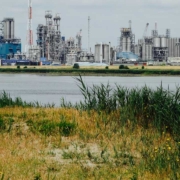Mega cities economy.
DHL has conducted an extensive study into future scenarios of its supply chain. Discuss the developments of the [Dutch] economy and the logistics implications of a mega city economy
Starting point.
Mega cities have become the center of trade, culture and politics. Such cities proved necessary to meet ecological, traffic and logistical challenges. The cities are highly automated and robotized. The type of jobs has changed drastically from production to service. Consumption has shifted from ownership to rent and share. A global logistics super grid connects the megacities.
Effects
The standard of living in the cities is exceptionally high. On the other hand, the rural areas have lagged far behind. This regularly leads to social conflicts. The importance of nation states has been decimated. The megacities and large corporations work closely with international organizations such as WTO and IPCC for optimal trade and climate control. CO2 has been reduced by 80% due to changed consumption behavior and highly efficient, CO2 neutral transport energy solutions.
A high degree of production has developed between the cities. First tier cities have leading centers of excellence where 2nd and 3rd Tier cities specialize in the realization of robotized solutions. Employees are mostly self-employed people who operate globally with the greatest of ease and who live in the cities. their social circle is also fully internationally oriented.
Implications for supply chains.
Transport and handling of cargo for the cities is done underground with AGV and fully automated transshipment systems. Internal transport systems cross the city for small and passenger transport. Own car ownership no longer exists. Producers are located on the edge of the megacities for fast delivery to the city.
Logistics service providers have become the main players in the field. Not only to arrange the actual transport, but they also manage the data for all goods – return flows. Producers no longer compete but work in a Co-Option system. The main economic activity is within and between the mega cities.
Mega ships made of lightweight material have been developed to operate sustainably and cost-effectively. At very high altitudes [> 10km] unmanned crafts fly quickly to transport goods from city to city. Mega trucks drive on the sparse roads in automated convoys. Deliveries to rural areas have been minimized. Residents must come to the hubs of the cities to collect their goods. 3D printing has taken its place in every home. Delivery of data streams and basic products is managed by the logistics service providers.
The switch from ownership to rent-and-share ensures a highly differentiated supply and demand of sharing services. Logistics service providers manage extensive booking platforms on which the consumer can indicate his needs in real time. Data security is therefore even more important than ever before.
What do you think?
Will the aforementioned effects really occur in a mega city economy. ? what do you think the effects will be for the Dutch logistics sector? As a guide, DHL has identified 14 key factors that are explained in this table. Join the discussion and comment below this article. How do you think the fourteen indicators will develop in a mega city economy?
Bron:
DHL Delivering Tomorrow. Logistics 2050. A Scenario Study. ISBN 978-3-920269-54-2.
publicatie onder schriftelijke toestemming van DHL Germany.









